Best Cordless Top-Handle Jigsaw Head-To-Head
Best Cordless Jigsaw – Comparison Testing
A jigsaw is worth it’s weight in gold due to the ability to quickly customize shapes and sizes of lumber for seamless fit-ups and emergency fixes. When our team of PROs got together recently to plan out our newest Head-2-Head, cordless jigsaw competition, we knew our PRO followers and subscribers were curious about many of these same design and performance considerations. After careful planning a range of uniquely crafted tests and jigs, and cutting hundreds of board feet ¼ inch at a time, we’ve delivered very detailed “Best Cordless Jigsaw” data you’ve come to expect (and crave) from our Tool Box Buzz team of PROs.
Best Top-Handle Jigsaw Evaluation Format
For this Best Cordless Jigsaw evaluation, several categories were developed including; Precision & Accuracy, Performance (speed/power), Features, Ergonomics, and Price.
Each of the categories were ranked individually and used to determine the Best Top-Handled Cordless Jigsaw based on the combined results.
- Accuracy– The accuracy of the jigsaws was compared including the ability to follow a shape, blade drift, and ease of cutting along irregular paths.
- Performance [Power / Speed Test]-We looked at cutting speed as an indicator of saw motor performance.
- Features– An overall comparison of features and specifications.
- Ergonomics– Ergonomics are really important to users and an important category to consider when purchasing any power tool. In addition to traditional ergonomics, we also included functionality in this category.
- Vibration – we recorded and analyzed the vibrations of the tools during our speed testing.
- Price– Price is always an important factor in determining which saw is best for a user. We’ve included the current pricing found online for each of the saws “as-tested,” at the time of publication.
- Best Value Saw – Often times this category winner tends to resonate with most folks as it tends to perform well in the tests but feels good on the wallet
Cordless Jigsaw Specifications
Black & Decker
- Model: BDCJS20C
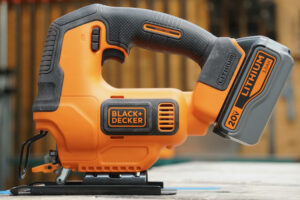
- Strokes Per Minute: 0-2,500SPM
- Stroke Length: 3/4″
- Weight: 4.3lbs
- Tool-Free Blade Change
- Accepts both U and T shank blades
- Built-in dust blower
- 45° bevel shoe capacity for angled cuts in both directions
- Variable Speed Trigger
Bosch
- Model: JSH180B
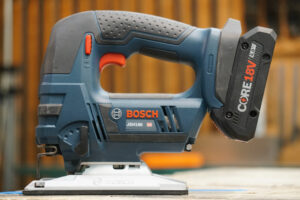
- Strokes Per Minute: 0-2,700 SPM
- Stroke Length: 1″
- Weight: 4.1lbs
- One-handed blade insertion and ejection for convenience and ease of use
- LED light for illuminating cut line
- Adjustable footplate for bevel cuts of up to 45°
- Built-in dust blower
- Variable Speed Trigger
Craftsman
- Model: CMSC600D1
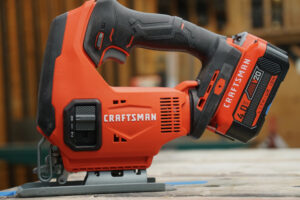
- Strokes Per Minute: 0-2,500 SPM
- Stroke Length: 3/4″
- Weight: 4.35 lbs
- Beveling shoe for bevel cuts of up to 45°
- Variable speed trigger
- 3 orbital cutting settings
- Key-less blade clamp
- Built-in dust blower
DEWALT
- Model: DCS334P1
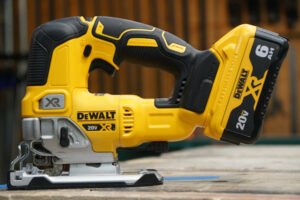
- Strokes Per Minute: 0-3,200 SPM
- Stroke Length: 1″
- Weight: 5.2 lbs
- Brushless Motor
- Integrated dust blower
- All-metal, keyless shoe bevel with detents at 0°, 15°, 30°, and a positive stop at 45°
- 4-position orbital action
- LED light
- Variable Speed Trigger
- Accepts t-shank jigsaw blades
Festool
- Model: 576535
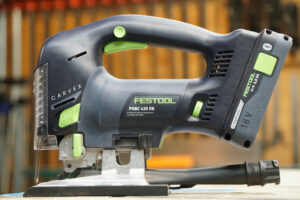
- Strokes Per Minute: 500-3,800 SPM
- Stroke Length: 1″
- Weight: 5.29 lbs
- Variable speed motor blade automatically adapts to the style of cut
- Tool-free multi-base platform and inserts
- Carbide blade guidance system for perpendicular cuts
- Stroboscopic LEDs freeze the blade in operation
- Brushless motor
Hilti
- Model: 2133672
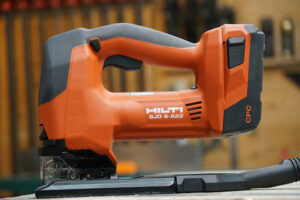
- Strokes Per Minute: 0-3,000 SPM
- Stroke Length: 1-3/32″
- Weight: 5.41 lbs
- Variable-speed trigger with lock for continuous sawing
- Keyless “push in, click” chuck
- LED light
- Built-in dust blower
- Adjustable footplate for bevel cuts of up to 45°
Kobalt
- Model: KJS 324B-03
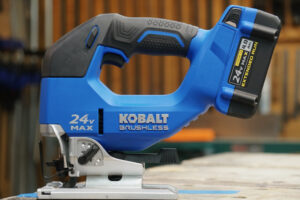
- Strokes Per Minute: 0-3,000 SPM
- Stroke Length: 1″
- Weight: 5.2lbs
- Brushless Motor
- 4-position orbital action
- Tool-free blade changes
- Tool-free shoe adjustments; bevel left and right at 45°
- Dust blower
- Built-in LED light
- Model: XVJ02Z
- Strokes Per Minute: 800-3,500 SPM
- Stroke Length: 1″
- Weight: 5.8lbs
- Brushless Motor
- 3 orbital settings
- Variable 6-speed control dial
- The no-load speed reduction feature automatically reduces SPM for more accurate cutting starts
- “Tool-less” blade change system
- 0°- 45° left or right bevel capacity
Metabo
- Model: STAB18LTX100
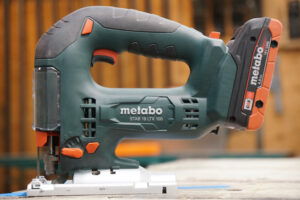
- Strokes Per Minute: 0-2,800 SPM
- Stroke Length: 1″
- Weight: 5.8lbs
- Selectable shaving blower function ensures free view of cutting line
- 4 Orbital Modes
- 0°- 45° left or right bevel capacity
- Changing saw blades without tools and with automatic ejection
Metabo HPT
- Model: CJ18DAQ4
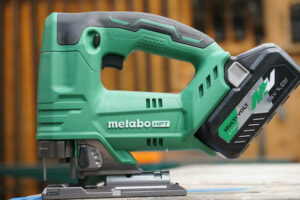
- Strokes Per Minute: 0-2,500 SPM
- Stroke Length: 1-1/32″
- Weight: 4.2lbs
- 4 cutting modes
- LED light
- Variable speed trigger
- Tool-less blade change
- Splinter Guard
- Dust Blower
- 45º left and right adjustable base
Milwaukee
- Model: 2737-20
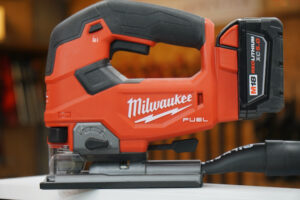
- Strokes Per Minute: 0-3,500 SPM
- Stroke Length: 1″
- Weight: 4.85 lbs
- On/Off cut line blower keeps the cut line clear of debris, and allows user to turn off blower when using dust extraction
- Accepts T-Shank jigsaw blades
- 4-position orbital cutting
- Tool-less shoe bevel with positive stops allows for quick and accurate shoe adjustment with detents at 0°, 15°, 30°, and 45°
- LED light
- Brushless Motor
- Variable Speed Trigger
Porter-Cable
- Model: PCC650B
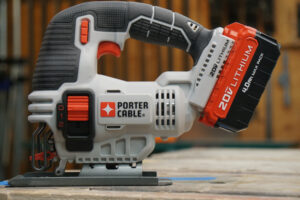
- Strokes Per Minute: 0-2,500 SPM
- Stroke Length: 3/4″
- Weight: 4.2lbs
- Dust Blower
- 3 orbital settings
- Beveling shoe provides the ability to cut 0 to 45-degree bevel cuts
- Tool-free blade release
- Variable speed trigger
RIDGID
- Model: R8832B
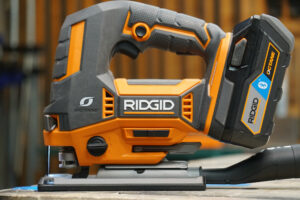
- Strokes Per Minute: 0-3,500 SPM
- Stroke Length: 1″
- Weight: 4.15lbs
- Line Start Mode creates a more efficient, controlled cut by increasing speed after engaging material
- Adjustable Orbital Action
- Variable Speed Trigger and Variable Speed Dial
- Brushless Motor
Ryobi
- Model: PBLJS01
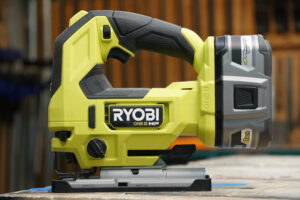
- Strokes Per Minute: 0-3,500 SPM
- Stroke Length: 1″
- Weight: 4.0lbs
- Brushless Motor
- Easy release blade lever for quick blade changes
- 4 Orbital Settings
- Variable Speed Dial
- Tool-free bevel adjustment for easy bevel changes, with locking detent at 45° left and right
- Die-cast metal base for increased durability with included non-marring shoe
- LED Light
Skil
- Model: JS820202
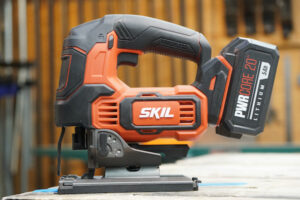
- Strokes Per Minute: 0-3,000 SPM
- Stroke Length: 1″
- Weight: 4.74lbs
- Brushless Motor
- 4 Stage Orbital Action
- Dust Blower
- Tool-Free Blade Change
Cordless Jigsaw Accuracy
For the accuracy category each of the jigsaws was ranked on accuracy in the following areas:
- Line of Sight
- Blade tracking
- Bevel accuracy when set to 45 degrees.
- Cross-cut accuracy when set to 90 degrees (how perpendicular the cut is to the surface)
The major factors that affect the accuracy of jigsaw cuts are: How well you can see the line of cut and how well the saw’s blade stays square to the workpiece (or at a fixed angle during bevel cuts). Generally, a jigsaw with less of its body overhanging the blade is easier to use, especially when you’re working in cramped quarters or trying to follow a curved line, for example cutting out a scrollwork pattern.
Diablo Jigsaw Blades
To be consistent, all the jigsaws were equipped with a new DIABLO 3-1/4″ 20-TPI scrolling blade and a DIABLO 4″ 10-TPI Fine Finish Wood blade. Each jigsaw was tested at 90-degree, 45-degree, and also with a scrolling blade for pattern work.
Pattern Cutting (Curves)
For the pattern cutting (curves) each saw was set to maximum speed with zero orbital action. A scrolling template was used to trace all the boards consistently, and each jigsaw was used to make numerous cuts in 3/4′” Poplar.
Finish carpenters and woodworkers use jigsaws for fitting and installations. A jigsaw’s ability to make an accurate cut is crucial and even a slight misalignment or bevel issue can cause compounding errors on a project.
Clean Cutting
Getting clean jigsaw cuts with only light splintering, tear out, and surface chipping is chiefly a matter of selecting a blade that’s designed for the job. All the saws were evaluated on how clean the saws cut. The team was pleasantly surprised to see three lesser-priced saws [RIDGID, Ryobi, and SKIL] cut as nice as the higher-priced Festool. These were the cleanest edge, cutting saws with the least tear-out. This “clean-cut result,” was also due to using the same Diablo blades along with the operator’s skill set using the tools.
Blade Deflection
Every cut was measured and evaluated for blade deflection at 45-degree and 90-degree cutting. On the 90-degree cuts Festool, Milwaukee, Metabo and Makita ranked the best. On the 45-degree cuts, Festool was the best followed by Milwaukee.
Blade Tracking
Tracking was evaluated by following lines to see how easy or hard it was to follow the line. The Festool, Metabo, RIDGID, Ryobi, and SKIL were the best tracking jigsaws. Again we were surprised to see a more economic brand rank side-by-side with the higher-priced German-engineered saws.
It’s worth noting that when scoring the line-of-sight, points were awarded based on the operator’s ability to consistently see the blade cutting through the popular. Points were not awarded based on the cut-line deviation from the template cut-line. This ensured that operator error was minimized as a primary scoring factor in this evaluation area.
Best Cordless Jigsaw Accuracy Winner – FESTOOL
Festool shined in all 4 test categories with a perfect score of 4 points. It had dead-on accuracy for both 45 and 90-degree cuts. It has a good line of sight and a strobe light system that allows you to see the blade while cutting. It consistently produced clean cuts and its blade tracked extremely well, with minimal blade deflection at 45 and 90-degrees.
The Milwaukee came away with the second-best score – a total of 6-points. It tied with the Festool for near-perfect 45 and 90-degree blade deflection and an excellent line of sight. Milwaukee’s score was 1-point lower in the tracking and clean cuts categories.
A three-way tie for third-highest score went to Metabo, RIDGID, and Ryobi all with 7-points each.
| Accuracy | Clean Cut | Tracking | 90 Deg Blade Deflection | 45 Deg Blade Deflection | Score Total | TBB RANK |
| Festool | 1 | 1 | 1 | 1 | 4 | 1 |
| Milwaukee | 2 | 2 | 1 | 1 | 6 | 2 |
| Metabo | 2 | 1 | 1 | 3 | 7 | 3 |
| RIDGID | 1 | 1 | 2 | 3 | 7 | 3 |
| Ryobi | 1 | 1 | 2 | 3 | 7 | 3 |
| Makita | 2 | 2 | 1 | 3 | 8 | 4 |
| Dewalt | 2 | 2 | 3 | 3 | 10 | 5 |
| Hilti | 3 | 2 | 2 | 3 | 10 | 5 |
| Bosch | 2 | 3 | 2 | 5 | 12 | 6 |
| Kobalt | 2 | 2 | 3 | 5 | 12 | 6 |
| Skil | 1 | 1 | 5 | 5 | 12 | 6 |
| Craftsman | 3 | 2 | 3 | 5 | 13 | 7 |
| Metabo HPT | 2 | 2 | 5 | 5 | 14 | 8 |
| Porter-Cable | 4 | 4 | 3 | 5 | 16 | 9 |
| Black+Decker | 5 | 4 | 4 | 5 | 18 | 10 |
Performance Testing (Power/Speed)
An obvious question when comparing the performance of different jigsaws is “which saw cuts the fastest?” This test also equates to power and power equates to cutting thicker, harder-to-cut materials.
Recognizing that using jigsaws requires the operator to make dozens if not, hundreds of minuscule adjustments during each cut we decided to try to eliminate the human variable. To test the power, we built a jig to hold the saws and pull the saws into 3/4″ plywood using a weighted pulley system.
In the TBB jig, we supported the 3’ pieces of plywood on a frame that in turn was held to the workbench by clamps. The frame allowed for the clearance of the maximum depth of the jigsaw blade. We also used a hold-down clamp on the far edge of the frame and secured the plywood to the frame with three screws each time we made a cut. That replicated the way a piece of material would be secured in the field. Each saw was fitted with a DIABLO 5″ 6-TPI Fast Cutting Wood blade, designed specifically for fast, rough cutting.
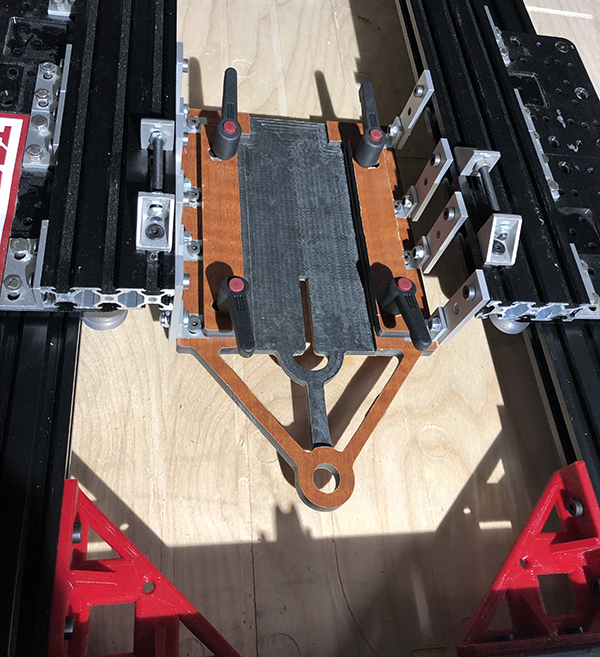
We designed the height of the fixture to be such that the bottom of the sled holding the saw just touched the plywood material. We wanted no gap between the sled and the workpiece because this would introduce additional vibration and is not the manner in which one uses a jigsaw. To cut down on the friction of the larger sled base, we installed an HDPE slick strip surface onto the bottom of the sled. This meant that each run would have consistent friction between the sled and the material. Also, this closely emulated the way the tool is commonly used.
We used this jig to remove as much human variation as possible to allow for the fairest capabilities-based test possible. We used natural, constant force (via the weight) to provide a straight, equal frictionless track to allow the saws the chance to cut as fast as they could. The saw’s motor power provided consistent strokes per minute (SPM) speed.
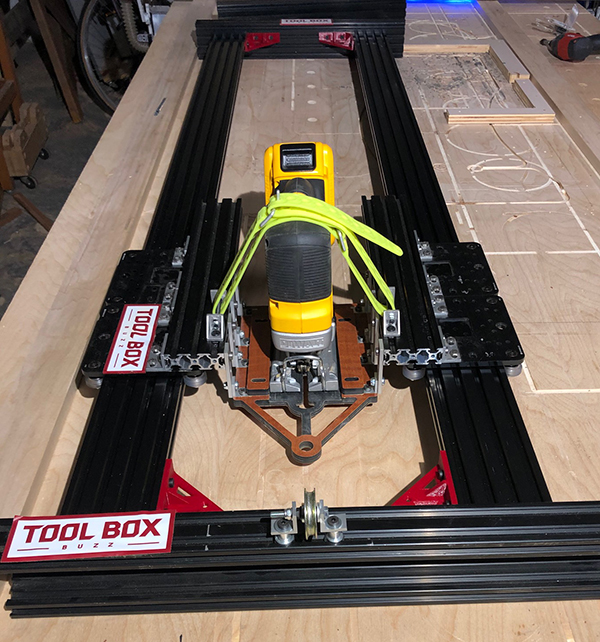
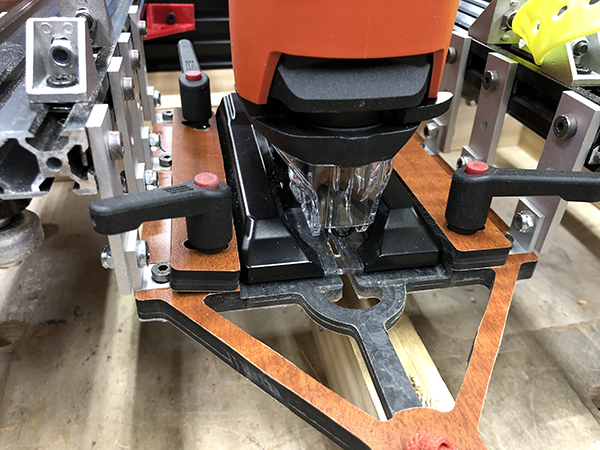
The pulling force was provided by a weighted pulley system which pulled the jigsaws through the material with consistent force. This approach has 2 main benefits:
- First, it allows a constant force to be applied to each jigsaw in the same way that an operator tries to apply a constant force while cutting.
- Secondly, by allowing for natural resistance (as opposed to forcing a constant cutting speed via mechanical motors) it allows the saw to cut at its natural maximum speed based on the maximum strokes per minute and the power of the motor. This also underscores the importance of using the same blade types on all saws as without it this test would not truly measure the natural maximum cutting speed.
The sled fixture held the saws securely and the aluminum tracks kept the saw moving in a consistent and parallel fashion. The saws were in contact with the sled and the sled in contact with the workpiece. During the course of testing, this fixture performed with no issues.
Performance Testing (Power/Speed) – Winner MILWAUKEE
Normalization by Watt-hours
Editor’s Note: An error was found in the calculation for this section and the updated results pushed Milwaukee to the top spot and moved Hilti down to 4th place. Updated September 2022.
These saws came with a different sized “energy power plant” or a combination of battery voltages and Amp-hour ratings. As you can imagine, the saw with the greatest watt-hour battery theoretically has a leg up on its competition with regard to performance. For most of our cordless tool comparisons, we level the playing field by normalizing the results based on total watt-hours. In this way, the reader can see which saw has the most effective combination of battery technology, stamina, and motor power on a per-watt-hour basis.
In this H2H, the batteries were all 18v (under load), with the exception being the Hilti and Kobalt which operate at 22V and 24V respectively. As you can see in the attached table, we derived the watt-hours by multiplying the load voltage by the amp-hours. The following table shows the results of the performance test when normalized.
| Speed / Power | Avg Time (S) | Inch / Sec | Amp-Hr | Watt-Hr | In/sec /Watt-hr | TBB RANK |
| Milwaukee | 10.2 | 3.55 | 5 | 90.0 | 0.0394 | 1 |
| Dewalt | 13.0 | 2.78 | 4 | 72.0 | 0.0386 | 2 |
| Festool | 14.5 | 2.48 | 4 | 72.0 | 0.0345 | 3 |
| Hilti | 12.7 | 2.84 | 4 | 86.4 | 0.0329 | 4 |
| Makita | 15.8 | 2.27 | 5 | 90.0 | 0.0252 | 5 |
| RIDGID | 13.8 | 2.62 | 6 | 108.0 | 0.0242 | 6 |
| Skil | 17.4 | 2.07 | 5 | 90.0 | 0.0230 | 7 |
| Kobalt | 16.3 | 2.21 | 4 | 96.0 | 0.0230 | 7 |
| Metabo | 22.6 | 1.59 | 4 | 72.0 | 0.0221 | 8 |
| Bosch | 23.1 | 1.56 | 4 | 72.0 | 0.0217 | 9 |
| Ryobi | 16.0 | 2.26 | 6 | 108.0 | 0.0209 | 10 |
| Metabo HPT | 21.0 | 1.71 | 5 | 90.0 | 0.0190 | 11 |
| Porter-Cable | 31.4 | 1.15 | 4 | 72.0 | 0.0159 | 12 |
| Black & Decker | DNF | 3 | DNF | 13 | ||
| Craftsman | DNF | 4 | DNF | 13 |
The saw with the best score for inches/sec/Watt-hr was the Milwaukee with a result of 0.0394. It was closely followed by the second-best score from DEWALT at 0.0386. Festool recorded the third-best score with 0.345.
It is interesting to note that these three saws had the three fastest timed runs for the entire group. Clearly, by both measures, these three saws are the top speed/power saws.
During the Speed/Power test, we noted that a few of the saws had difficulty completing the test. The Black & Decker and Craftsman saws could not finish this test and we listed them as DNF (Did Not Finish). During the run, they could not hold the blade in their blade follower and the blade skewed to the side so badly the saws stopped.
The Porter-Cable saw had the same tendency, but the saw managed to muscle through to the end of the plywood board. You can see that the Porter-Cable average cut time was more than 50% longer than the saw above it in the table. The average cut time indicates the difficulty that it had completed the test. It is interesting to note that these three saws have a very similar design.
Bent blades from the DNF saws
One other saw exhibited difficulty in the Speed/Power test. The Metabo saw had the blade come free of the grooved roller wheel in each run. While the Metabo’s blades did not heal over sideways, the blades did show a wear pattern that the side of the blade ran along the outside of the wheel, not inside of the wheel with the grooved track. Such behavior was undoubtedly the reason the Metabo saw finished in the middle of the pack for Speed/Power.
While we do not know and did not explore the reasons why these four saws had issues while the other eleven did not. We can say that when a person is operating a jigsaw, the user will make immediate and minuscule adjustments to the path, speed, and force they apply in using the saw. That way, if the saw starts to wander or drift, the user can intervene. In this test, once a condition started, the sled made no adjustments and the saws/blade combination proceeded on and the issue compounded on itself – to the point where at least two of the saws’ blades were so skewed to the side that the saw could no longer pull the blade through the wood.
Best Cordless Jigsaw Features – Winner RIDGID
Comparing tool features from multiple brands is never easy but the devil is in the details, so a feature comparison is certainly warranted. We looked at 10 different features on these saws and rated them 1 through 5 for each saw. [1 being best]
- Handle and Trigger
- Soft Start
- Variable Speed [Trigger and Dial]
- Selectable Blade Orbit
- Blade Guide System
- Blade Change Clamp
- Shoe plate – Tilting
- Dust Blower / Collection
- LED Light
- Power Lock-on
The RIDGID took first place in features with 17-points, followed by the Festool with 18-points, and Makita and Milwaukee tied for third place with 21-points. DEWALT followed with 23-points to finish fourth.
The RIDGID consistently showed up in this test as a jigsaw NOT to be ignored. While not considered a higher-end saw, by most pros, the RIDGID has a feature set that many expect in a high-end saw.
“RIDGID is the hidden gem” ~ Scott Arnold TBB Crew
| Variable Speed Trigger | Variable Speed Switch | Blower | LED Light | Blade Guide | Lock On | Slow Start | Blade Orbit Select | Tool-less plate adjust | Total | TBB Rank | |
| RIDGID | 3 | 1 | 1 | 3 | 4 | 1 | 1 | 1 | 2 | 17 | 1 |
| Festool | 3 | 1 | 5 | 2 | 1 | 1 | 1 | 1 | 3 | 18 | 2 |
| Makita | 1 | 1 | 5 | 3 | 3 | 1 | 1 | 1 | 5 | 21 | 3 |
| Milwaukee | 3 | 1 | 1 | 1 | 3 | 5 | 5 | 1 | 1 | 21 | 3 |
| Dewalt | 3 | 1 | 2 | 3 | 2 | 5 | 5 | 1 | 1 | 23 | 4 |
| Hilti | 3 | 1 | 2 | 3 | 2 | 5 | 5 | 1 | 5 | 27 | 5 |
| Kobalt | 3 | 1 | 1 | 4 | 4 | 5 | 5 | 1 | 4 | 28 | 6 |
| Bosch | 3 | 1 | 2 | 4 | 3 | 5 | 5 | 1 | 5 | 29 | 7 |
| Metabo | 3 | 1 | 1 | 5 | 3 | 5 | 5 | 1 | 5 | 29 | 7 |
| Metabo HPT | 3 | 1 | 2 | 4 | 3 | 5 | 5 | 1 | 5 | 29 | 7 |
| Skil | 3 | 5 | 1 | 4 | 4 | 5 | 5 | 1 | 1 | 29 | 7 |
| Ryobi | 5 | 5 | 5 | 1 | 5 | 1 | 5 | 1 | 2 | 30 | 8 |
| Craftsman | 3 | 1 | 2 | 5 | 5 | 5 | 5 | 1 | 5 | 32 | 9 |
| Porter-Cable | 3 | 1 | 2 | 5 | 5 | 5 | 5 | 1 | 5 | 32 | 9 |
| Black+Decker | 3 | 1 | 2 | 5 | 5 | 5 | 5 | 5 | 5 | 36 | 10 |
Handle and Trigger
A good handle is important on a jigsaw for user comfort and also because a solid grip is essential to controlling the movement of the tool during cutting. In general, over-molds are softer to the touch than hard plastic, provide a more secure grip and even dampen tool vibration slightly.
Note – The pommel at the front of the DEWALT’s handle was unique and allowed a two-handed grip — we found it helpful when cutting in awkward positions.
Wider triggers offer you more gripping options and control, whereas narrower jigsaw triggers can be clumsy and hard to grip while cutting. A jigsaw’s most important operational feature is its trigger that switches the tool on and off.
Note – Ryobi trigger is hard to pull and for a 1/4″, requiring an over-pull, and then the tool activates. This made using the saw with precision difficult.
Festool went to sleep on this handle, it’s too smooth, too narrow, and the rise in the handle is awkward. It feels toy like ~ Ethan Bickford TBB Crew
The team favored the larger size triggers on the Festool, Hilti, Makita, Metabo, and Milwaukee. We also liked the dual-trigger system on the Festool that locks the saw on or allows you to control the variable speed with a trigger pull.
The team was split with the trigger safety feature on the Makita that required you to turn the power on or off. The crew members that had recently used Makita tools were used to it and knew that it was a consistent feature on their new tools. Other team members felt like it was an unnecessary additional step and did not like having to press a button before the tool started.
Soft / Auto Start
The Makita jigsaw has “soft-start” motor electronics that start the motor at a slow level and stays at a low speed until the tool starts to cut material. In general, a soft start can prevent the saw from suddenly jerking if you start cutting with the blade in contact with the material. Once the saw engages material the RPMs ramp up.
The RIDGID has a “line-start” feature on the variable speed dial. This feature starts the blade at a lower RPM until engaged in the wood – allowing you to start your cut.
The Festool has an “A” symbol on the variable speed dial that also starts the saw at a lower rpm speed and speeds up when the blade engages the material being cut.
Variable Speed
All of the jigsaws with the exception of the Ryobi have a variable-speed trigger to allow you to vary the speed of the saw according to how hard you pull the trigger or where the speed adjustment wheel is set. Variable triggers that let you ramp up the speed of the blade gradually, up to the maximum set on its variable-speed dial. This is useful when starting cuts in very hard and/or splintery woods as well as materials prone to chipping, like tile and plastics.
The DEWALT, Hilti, Festool, Makita, RIDGID, and Ryobi were the only saws with variable-speed dials that allow you to set the upper limit of motor speed and, hence, the number of blade strokes per minute. This makes a jigsaw a more versatile cutting machine.
Selectable Blade Orbit
This mechanism moves the blade forward slightly during the upstroke cut, resulting in a more aggressive cutting action than if the blade simply reciprocated up and down. The mechanism also moves the saw blade back slightly, so it clears the kerf during the return downstroke and saves wear on the teeth. Adjusting the amount of blade orbit makes the saw cut more or less aggressively. Most saws have four-orbit settings: 0 (no orbit) or 1 for cutting metals and plastics; 1 or 2 for fine and curved cuts; and 3 (maximum orbit) for faster, rougher cuts.
All of the saws, with the exception of the Black and Decker, have selectable blade orbits.
Blade Guide System
Most of the saws use a grooved wheel blade guide system. The groove guides and keeps the blade in alignment. The Festool has a true “blade guide” system. It has a smooth wheel and a v-shaped metal guide that contacts and stabilizes the backside of the blade and keeps it from deflecting during cutting.
All the jigsaws featured had tool-free blade change systems, which allow you to safely and easily change out blades thanks to a spring-loaded lever and clamp.
Blade Change Clamp Lever
All of the jigsaws allow tool-less blade changes, employing a lever that opens the blade clamp on the end of the saw’s plunger — the part that moves the blade up and down. Tool-less blade clamps make changing the tang-style saw blades each model uses quick and easy. But each clamp is different and some are easier to work with than others. They were all easy in their own way – these three saws stood out.
- The Festool’s “Fast Fix”.
- The Makita also has a terrific mechanism with a spring-loaded lever
- The Bosch’s “One Touch” blade change system
This can save you from burning your fingers trying to pull a hot blade out of the clamp after a prolonged cutting session.
DEWALT rattles when you back up the blade and hit the workpiece. Most blade clamps use a twist lock so when pressure is applied to the back of the blade generally the worst thing that happens is it might jump out of the blade guide. But the blade clamp on the DEWALT releases with a linear action that is in line with the blade. This means that when the blade is pushed backward (like when making complicated cuts and making relief cuts) it starts to release the blade clamp, and pushes on the blade clamp release lever, and makes an alarming rattling noise. I could definitely see these causing problems when aggressively moving the saw around to make a tight cut.
Tilting Shoe Plate
Adjusting the angle of a jigsaw’s shoe plate allows the saw to make bevel cuts, say for the edge of scribing baseboard. While all these jigsaws have tilting footplates, only the DEWALT, Kobalt, RIGID, Ryobi, Milwaukee, and Skil allow tool-less angle changes. The rest of the saws require an ALLEN wrench to adjust the base.
The best adjustable tool-less lever was the DEWALT, Milwaukee, and Skil. These saw levers were easy to manipulate and the tilting base released, adjusted, and locked easily and quickly.
The Festool comes as a fixed base. If you want to bevel this saw you need to purchase an accessory kit. This kit has an adjustable base controlled by a knob. Because of this, we scored the Festool a 3 [mid-range]
Festool has an accessory beveling base plate that is certainly unique. It is split and bevels in a butterfly fashion with a split down the middle. This is fine for bevel cuts in the middle of a large workpiece but can be a problem when back beveling near the edge of a workpiece as the baseplate will frequently hit the workpiece.
Dust Blower / Dust Collection
Jigsaw blowers don’t impress us much – most of these saws still require you to blow the dust away from the dust, but that doesn’t mean that all blowers are equal.
Milwaukee, Kobalt, Metabo, Skil, Ridgid, and Kobalt have a selectable blower switch giving you an option to turn the blower on or off. The Bosch, Hilti, Craftsman, Black and Decker, Metabo HPT, Porter-Cable have ‘always-on” blowers. All the saws feature a dust blower that uses air channeled from the motor fan to blow dust away from just in front of the blade. The blowers overall do a “just ok” job at removing dust.
Built-in LED Light
All but the Black and Decker, Porter-cable, Craftsman, and Metabo have LED lighting.
The Makita and RIDGID are the only two saws that allow you to activate the LED without engaging the blade.
The best LED was the Milwaukee saw with a bright, full circle halo that surrounds the saw with no shadow line. The Festool was similar in brightness but did not throw out the same size halo. The Festool had a really large halo, not as bright and full of shadows due to its guard. All saw included a built-in LED light. A built-in LED light is a particularly welcome feature on any jigsaw since the overhanging body tends to cast a shadow in the area of the blade.
Power Lock-On
Only four saws have a lock-on feature. The Festool, Makita, RIDGID, and Ryobi have the ability to lock the trigger in the on position. Makita, RIDGID, and Ryobi are set up for right-handed users with a lock-on button positioned for use by the right thumb. The Festool has an ambidextrous slide switch on both sides of the saw, positioned lower on the saw head.
Ergonomics Winner – HILTI and Milwaukee
Ergonomics is the science of designing and producing tools that improve a worker’s efficiency while reducing discomfort, fatigue, and risk of injury.
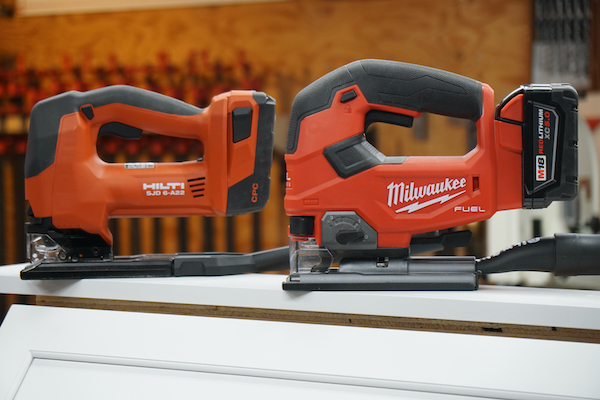
In laymen’s terms, ergonomics is the interface between the user and the tool. How’s it feel when using it? For this ergonomic section, we considered the following factors, rating them 1 thru 5. [1 being best]
- Grip
- Trigger
- Adjustments and Switches relating to right and left users.
HILTI and Milwaukee had a tie for the best Ergonomics score. Bosch, Metabo and DEWALT had the second-best scores in Ergonomics, followed by Makita and Skil. The Festool has a trigger safety is on the left side of the tool making it difficult for a left-handed user to actuate. The Makita, RIDGID, and Ryobi have a trigger lock on switches on the left side of the tool making it difficult for a left-handed user.
| ERGONOMICS | Grip | Trigger | Left / Right User | Total | TBB Rank |
| Hilti | 1 | 1 | 1 | 3 | 1 |
| Milwaukee | 1 | 1 | 1 | 3 | 1 |
| Bosch | 1 | 2 | 1 | 4 | 2 |
| Dewalt | 1 | 2 | 1 | 4 | 2 |
| Metabo | 2 | 1 | 1 | 4 | 2 |
| Makita | 1 | 1 | 3 | 5 | 3 |
| Skil | 2 | 2 | 1 | 5 | 3 |
| Black & Decker | 3 | 2 | 1 | 6 | 4 |
| Craftsman | 3 | 2 | 1 | 6 | 4 |
| Metabo HPT | 3 | 3 | 1 | 7 | 5 |
| Kobalt | 3 | 5 | 1 | 9 | 6 |
| Porter-Cable | 5 | 3 | 1 | 9 | 6 |
| RIDGID | 5 | 2 | 3 | 10 | 7 |
| Festool | 5 | 1 | 5 | 11 | 8 |
| Ryobi | 5 | 5 | 3 | 13 | 9 |
Vibration – Winner Makita
Regardless of how fast a jigsaw cuts, the less vibration it produces, the better. All jigsaws employ some sort of counterbalance system to reduce the up-and-down shaking created by the reciprocating plunger and blade, and some work better than others.
During the speed/power test, we wanted to collect data on the relative difference for the vibration that each saw produced. To accomplish the data collection during actual runs, we attached a fixture to hold an iPhone firmly onto the sled. This phone has a built-in set of accelerometer sensors and we installed an app that not only created an image of the vibration but provided the average and peak vibration readings in G’s for each run.
The data between the average vibration and the peak vibration were close in the rankings. This validates the results of the readings recorded for the individual saws.
| Manufacturer | AVE VIBRATION | AVE VIBRATION RANK | PEAK VIBRATION | PEAK VIBRATION RANK | COMBINED SCORE | TBB RANK |
| Makita | 3.6 | 1 | 5.6 | 1 | 2 | 1 |
| Festool | 6.6 | 2 | 20.2 | 2 | 4 | 2 |
| Skil | 6.7 | 3 | 22.5 | 3 | 6 | 3 |
| RIDGID | 11.0 | 5 | 28.0 | 4 | 9 | 4 |
| Ryobi | 12.3 | 6 | 38.9 | 6 | 12 | 5 |
| Metabo HPT | 8.5 | 4 | 42.3 | 9 | 13 | 6 |
| Kobalt | 12.6 | 8 | 38.0 | 5 | 13 | 6 |
| Hilti | 12.4 | 7 | 41.1 | 8 | 15 | 7 |
| Milwaukee | 19.2 | 10 | 39.5 | 7 | 17 | 8 |
| Dewalt | 13.2 | 9 | 62.8 | 11 | 20 | 9 |
| Craftsman | 32.8 | 14 | 60.9 | 10 | 24 | 10 |
| Porter-Cable | 23.2 | 11 | 79.5 | 14 | 25 | 11 |
| Metabo | 25.9 | 12 | 78.6 | 13 | 25 | 11 |
| Bosch | 30.7 | 13 | 72.3 | 12 | 25 | 12 |
| Black & Decker | DNF | 14 | DNF | 13 | 27 | 13 |
Based on our testing the top three saws with the least vibration were Makita, Festool, and Skil.
Dust Collection
From carpenters working in finished spaces, to shop workers who want to reduce the amount of airborne dust in their environment, knowing how well a saw will integrate with a vacuum is an important measure of performance for any user.
We did NOT test for dust collection since all of the TTB crew members agreed that they do not use dust extraction on a jigsaw.
During our discussion, we agreed that we usually use jigsaws for scribing, finishing cuts from a table or circular saw, and cutting openings. All these cuts are critical and the hose can drag the back of the saw around and mess up the cut. Plus the generally infrequent use means that the time and inconvenience isn’t worth it for the small amount of dust made.
The Hilti comes with an integrated air dust channel, the Festool has a dust chute that inserts into the base plate directly behind the blade. The Milwaukee and RIDGID come with a dust port that inserts into the base plate and collects from directly behind the blade guide.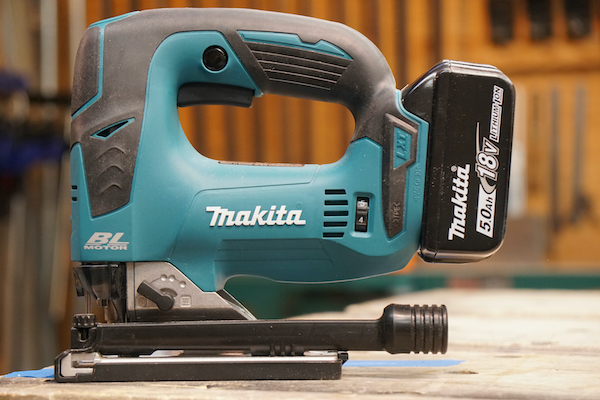
Many of the other saws, like Bosch, Makita, and Metabo, can be connected to dust collection but do not come standard with a dust port.
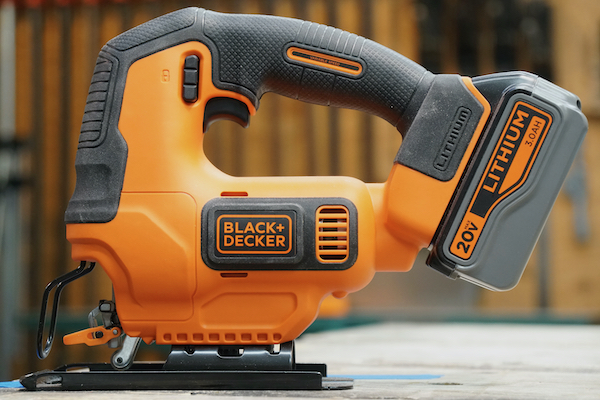
Price
Below we’ve included the current pricing (at the time of publication). Pricing is based on the bare tools where available. We chose the bare tool because the jigsaw is typically a secondary tool to one’s tool arsenal.
The best-priced cordless top-handled jigsaw was the Black and Decker at $ 49.00. Second place was the porter cable priced at $55.25 followed by Craftsman at $ 116.55
The highest price saw in this testing war the Festool Carvex which sells for $ 349.00 The Festool Carvex machines (all versions – corded and cordless) come in a Systainer with or without a battery.
The TBB Crew chose a huge range of jigsaws to test, from DIY quality to professional grade. Because of this, we did not include pricing in our final scoring.
| Manufacturer | Model | Price | TBB RANK |
| Black+Decker | BDCJS20C | $49.00 | 1 |
| Porter-Cable | PCC650B | $55.25 | 2 |
| Metabo HPT | CJ18DAQ4 | $99.00 | 3 |
| Craftsman | CMCS600D1 | $116.55 | 4 |
| Skil | JS820202 | $126.73 | 5 |
| Kobalt | KJS 324B-03 | $129.00 | 6 |
| RIDGID | R8832B | $129.00 | 6 |
| Ryobi | PBLJS01 | $129.00 | 6 |
| Metabo | STAB18LTX100 | $144.99 | 7 |
| Bosch | JSH180B | $149.00 | 8 |
| Milwaukee | 2737-20 | $168.22 | 9 |
| Dewalt | DCS334P1 | $199.00 | 10 |
| Hilti | 2133672 | $239.00 | 11 |
| Makita | XVJ02Z | $263.00 | 12 |
| Festool | 576535 | $349.00 | 13 |
Buy Now From Our Sponsored Retailers
Other Options
Best Cordless Jigsaw Winner –Festool
| SPEED / POWER Norm. | VIBRATION | ERGONOMICS | FEATURES | ACCURACY | GRAND TOTAL SCORES | |
| Black+Decker | 13 | 13 | 4 | 11 | 18 | 45 |
| Bosch | 9 | 12 | 2 | 7 | 12 | 42 |
| Craftsman | 13 | 10 | 4 | 10 | 13 | 50 |
| DEWALT | 2 | 9 | 2 | 4 | 10 | 27 |
| Festool | 3 | 2 | 8 | 1 | 4 | 18 |
| Hilti | 4 | 7 | 1 | 5 | 10 | 27 |
| Kobalt | 7 | 6 | 6 | 6 | 12 | 37 |
| Makita | 5 | 1 | 3 | 2 | 8 | 19 |
| Metabo | 8 | 11 | 2 | 7 | 7 | 35 |
| Metabo HPT | 11 | 6 | 5 | 8 | 14 | 44 |
| Milwaukee | 1 | 8 | 1 | 3 | 6 | 19 |
| Porter-Cable | 12 | 11 | 6 | 10 | 16 | 55 |
| RIDGID | 6 | 4 | 7 | 2 | 7 | 26 |
| Ryobi | 10 | 5 | 9 | 9 | 7 | 40 |
| Skil | 7 | 3 | 3 | 8 | 12 | 33 |
The competition for the best cordless jigsaw went to Festool with 18-points.
The Festool came tops in both the accuracy and feature categories and 2nd in vibration. It’s a superbly cutting saw and super precise. We critiqued Festool because the user needs to buy an accessory kit if they want to bevel cut with the saw.
Makita tied for 2nd with Milwaukee and scored tops in the vibration category, second in features, and third in ergonomics. The TBB Crew found the Makita to have good power, liked the soft-start feature, and really appreciated its low vibration. It has a compact footprint and is truly a nice cutting saw. Similar to Festool, we critiqued Makita’s lack of tool-less beveling. The user requires a tool to bevel the saw base. Makita also scored in the very middle for accuracy/precision.
Milwaukee tied for second place with 19-points followed by RIDGID at 26-points and Hilti at 27-points, , and DEWALT with 28-points.
Milwaukee had a solid showing with a first-place tie with Hilti in ergonomics. It scored first place in power and third place in features. The crew all said it was a powerful, nice cutting saw requiring minimal effort to operate.
The Hilti tied with Milwaukee for the first place rank in ergonomics – the entire team commented about how comfortable this saw was to use. It’s a nice feeling saw but was hard to see the cut-line through the dust hood.
RIDGID scored second place in features and fourth in vibration. It scored in the middle of the pack for all other categories which secured its close win over the DEWALT.
| MANUFACTURER | FINAL TBB SCORES | FINAL TBB RANKING |
| Festool | 18 | 1 |
| Makita | 19 | 2 |
| Milwaukee | 19 | 2 |
| RIDGID | 26 | 3 |
| Hilti | 27 | 4 |
| Dewalt | 28 | 5 |
| Skil | 33 | 6 |
| Metabo | 35 | 7 |
| Kobalt | 37 | 8 |
| Ryobi | 40 | 9 |
| Bosch | 42 | 10 |
| Metabo HPT | 44 | 11 |
| Black+Decker | 45 | 12 |
| Craftsman | 50 | 13 |
| Porter-Cable | 55 | 14 |
Best Value Top-Handle Cordless Jigsaw – Winner Milwaukee
The best value is the Milwaukee jigsaw. The Milwaukee saw came in 3rd overall in this testing and priced mid-pack at $ 168.00 [bare tool] It was a solid performer and is offered at a good price making this saw the best value jigsaw.
Conclusion
The MOST Comprehensive Information Available
Our ALL Pro contractor team put some serious time and effort into our Best Cordless Jigsaw Head-to-Head evaluation to bring you the most comprehensive information available.
These tests and evaluations are very difficult, take a lot of time, and ultimately limited in scope as we’re not a professional testing company and we’ve got limited time to evaluate the tools. We cannot do long-term testing that would shed light on durability and we can’t possibly test every application that you might use one of these saws for.
We get lots of comments about how we make the final rankings. As we’ve stated, there are hundreds of ways to compare tools. The good news is we’ve openly shared ALL the data from our tests, and you can rank the tools however you want. Don’t care about an item we ranked? No problem. Simply remove that from the matrix above and re-rank them. Hopefully, you’ll find this Head-To-Head useful when comparing compact cordless miter saws.
If you have a moment, please check out our other Head-to-Head Tests.
About the author
12 Comments
Leave a comment
Disclosure
Product reviews on this site contain our opinion of a product or service. We will always strive for objectivity and transparency in our reviews. Our goal is to provide readers with honest, objective information based on our own experiences. We never have and never will accept payment in exchange for a positive review. Many of the products that we review are provided to us for free by a manufacturer or retailer. In some cases, we also have advertising or affiliate relationships with manufacturers and retailers of products and services we review. For additional information please visit our additional disclosure policies.











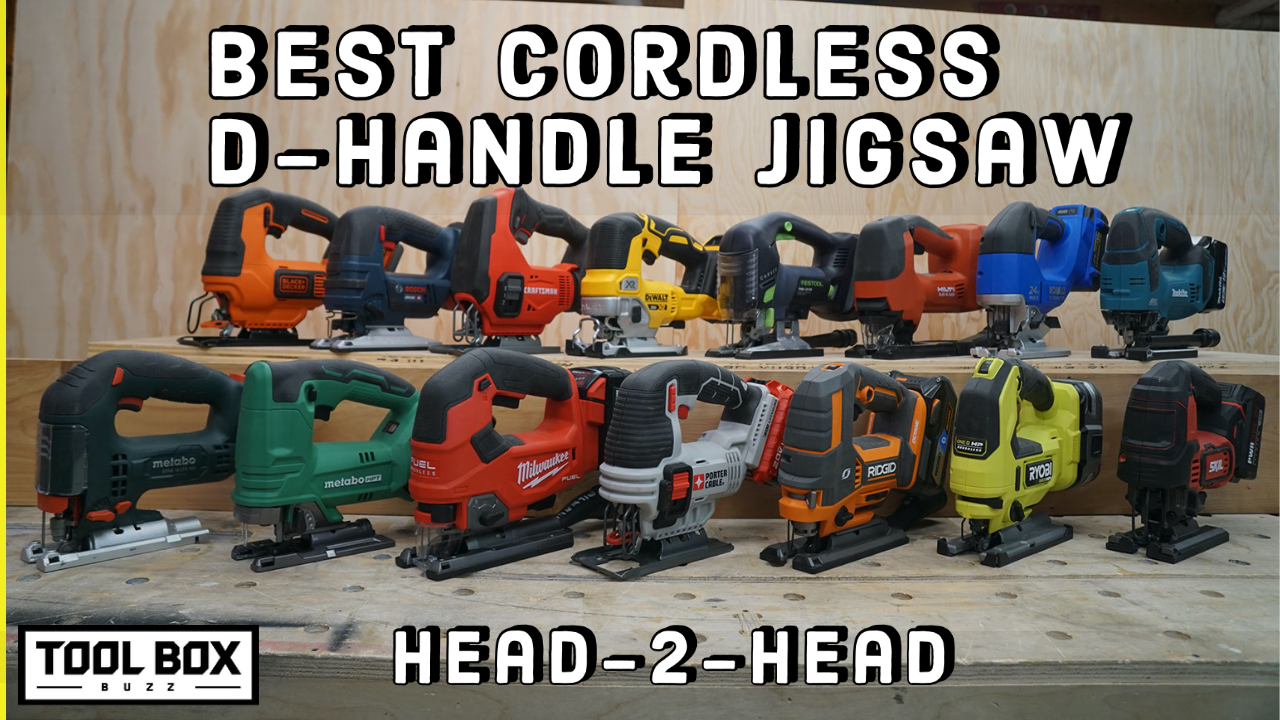
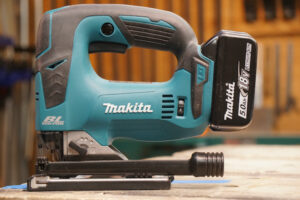
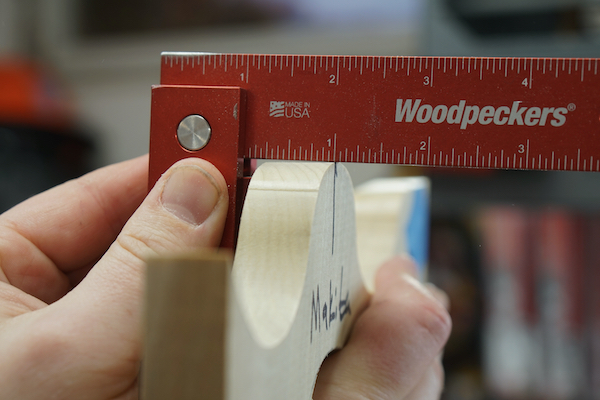
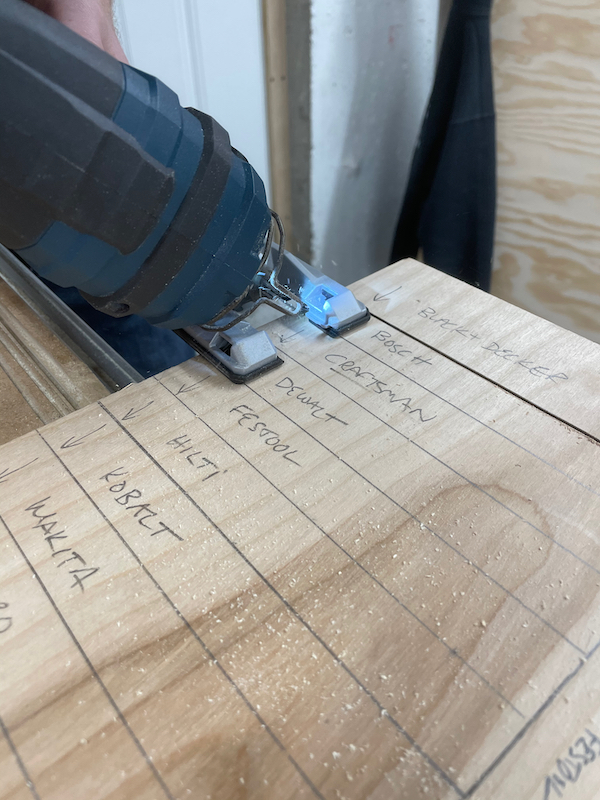
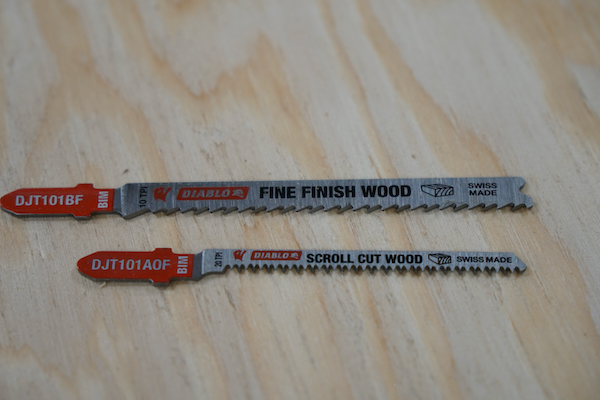
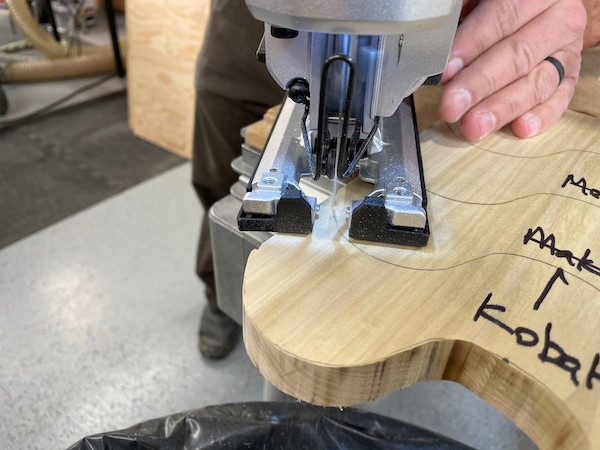
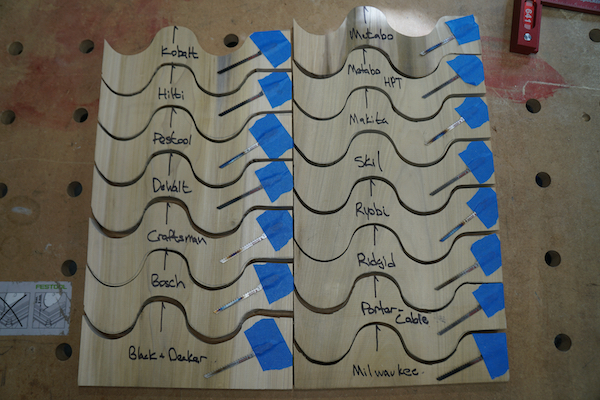
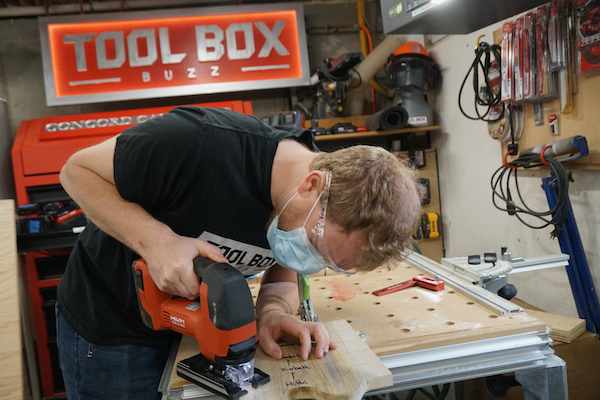
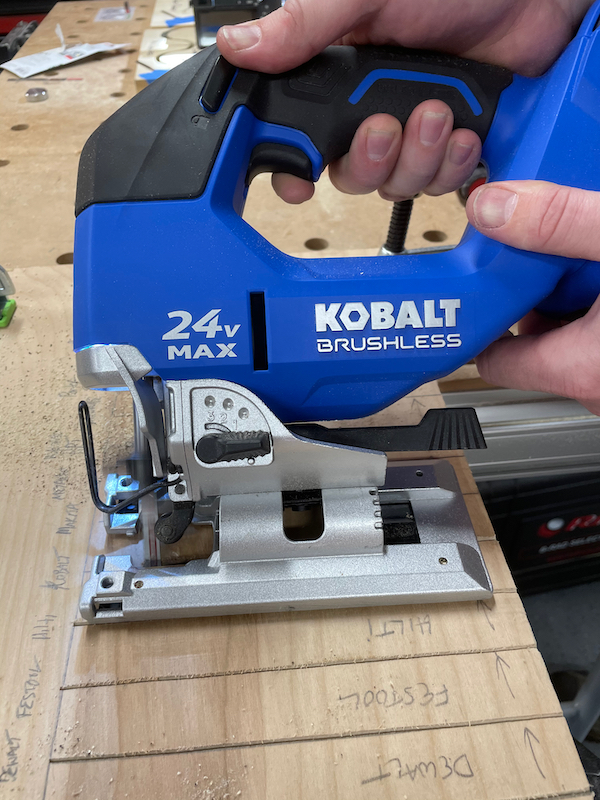
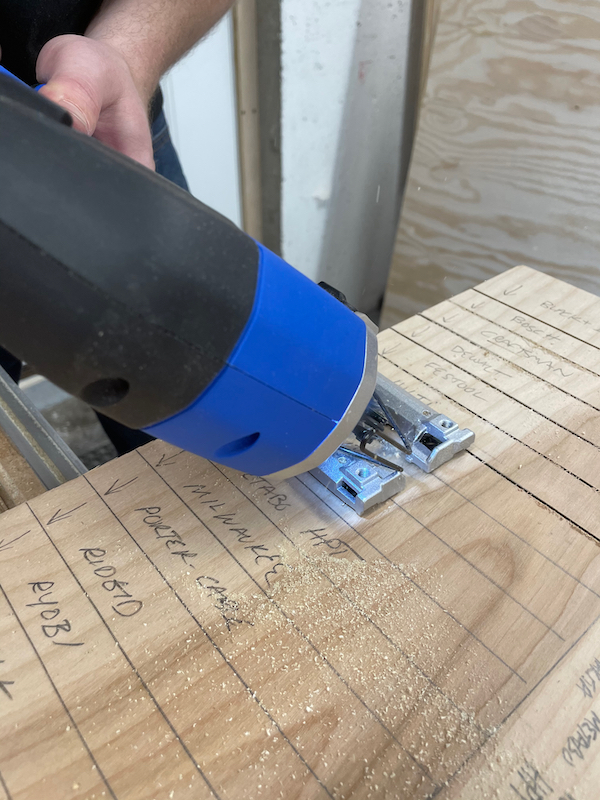
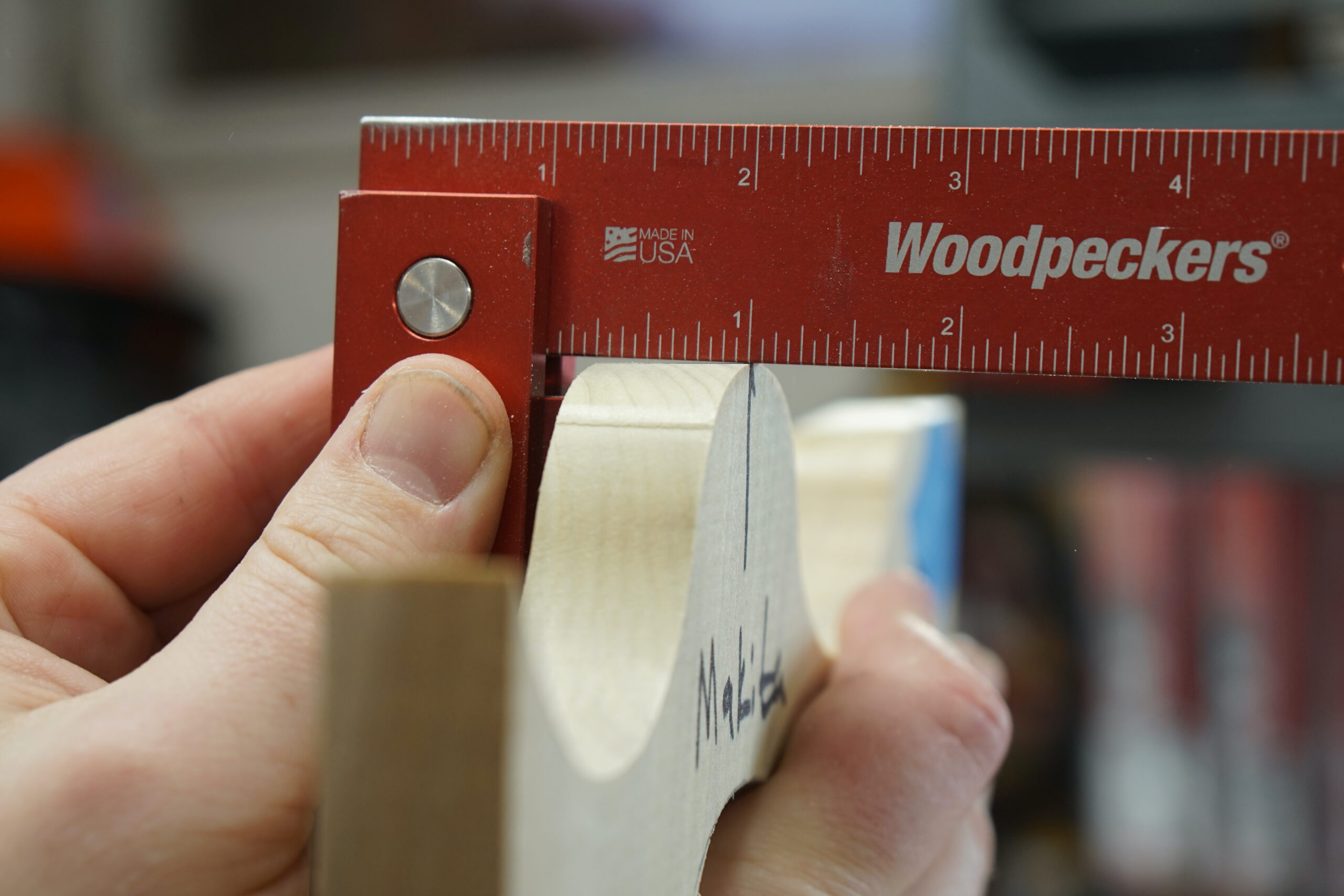
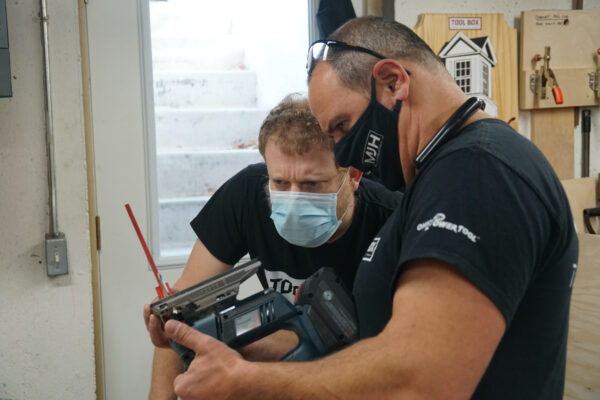
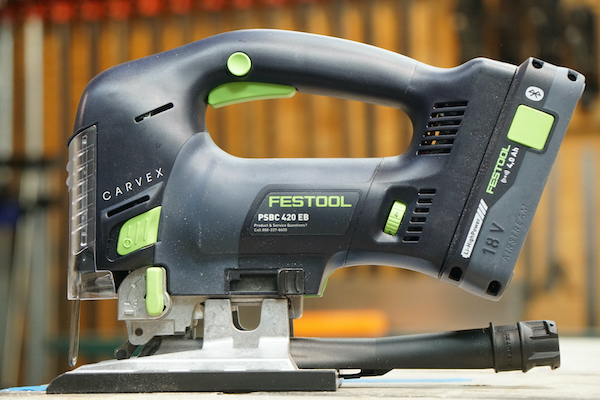
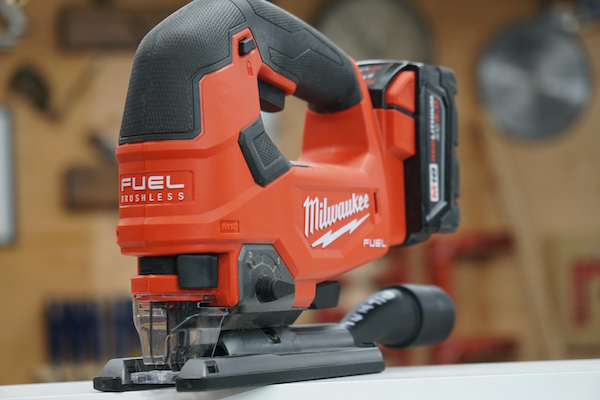
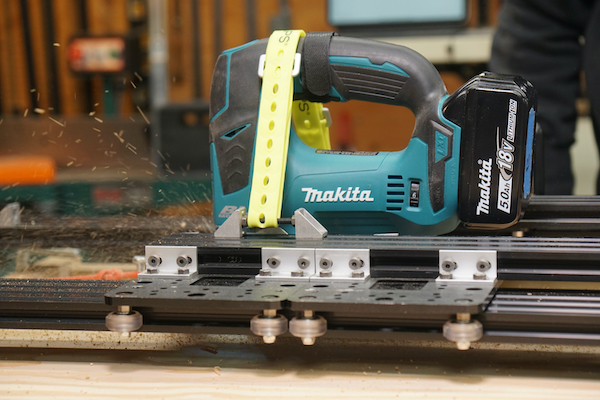
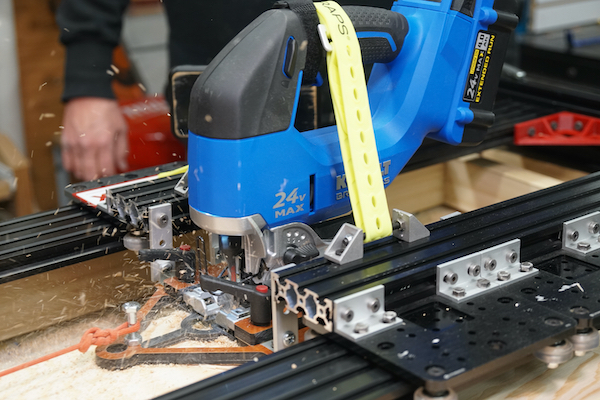
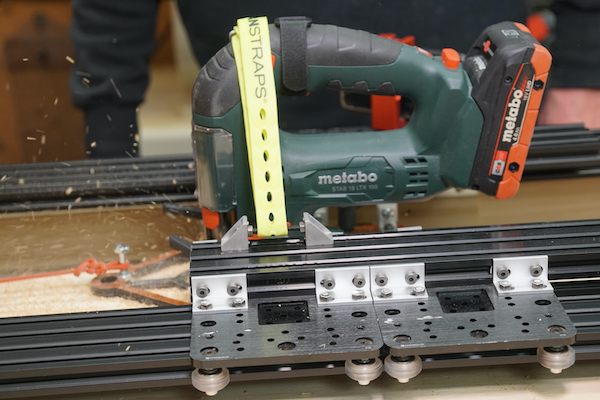
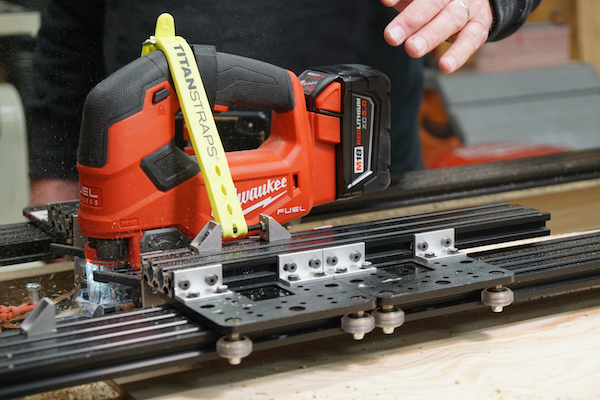
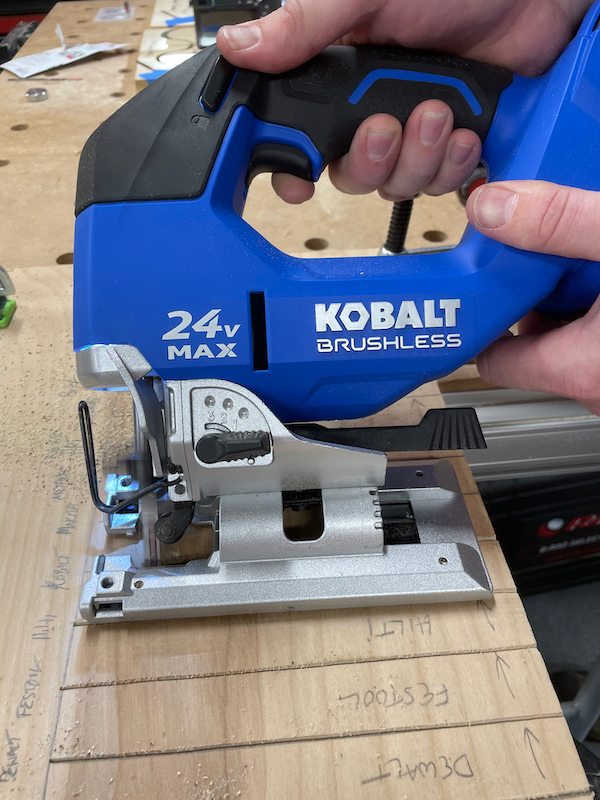
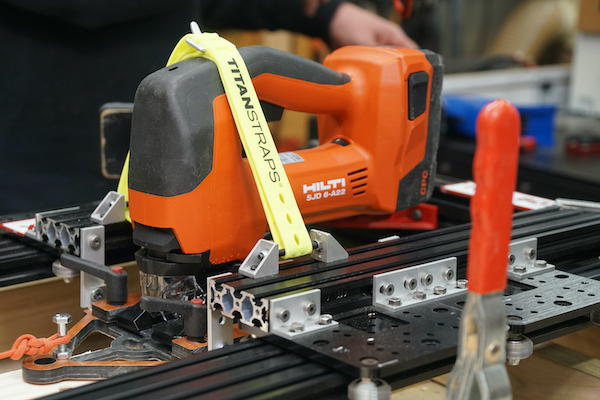
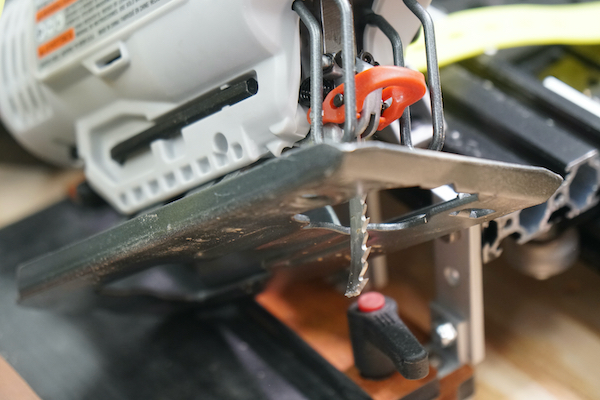
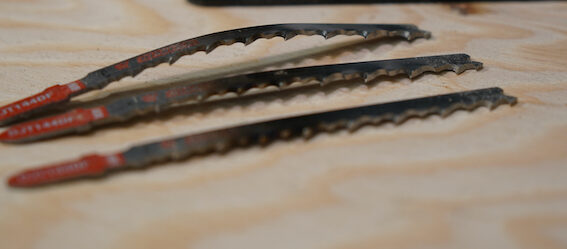
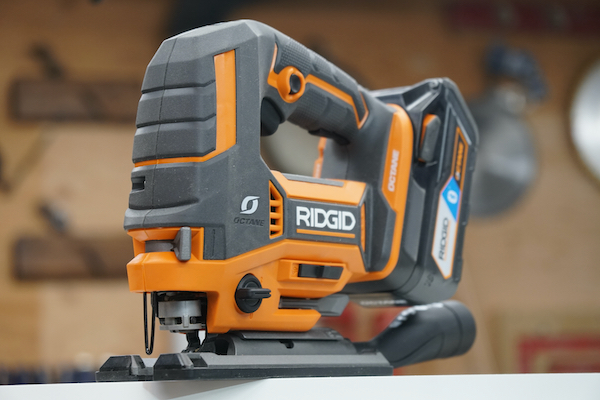
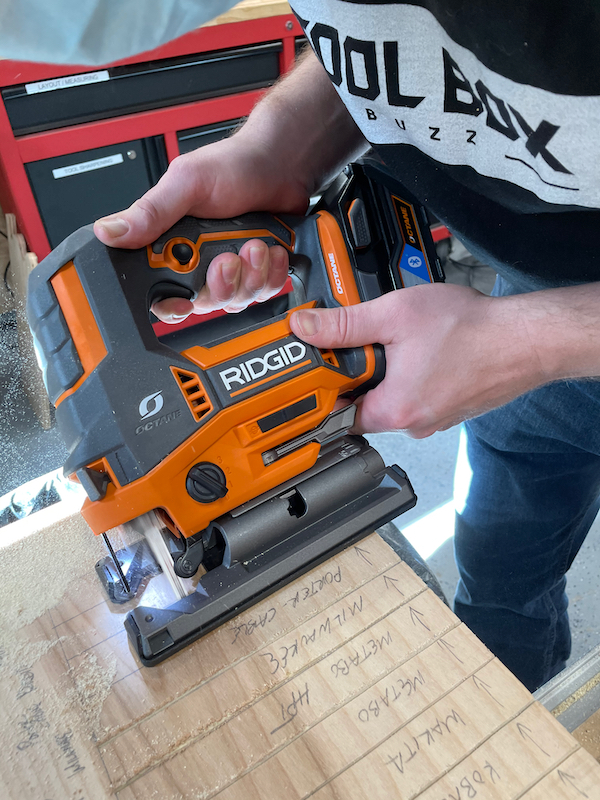
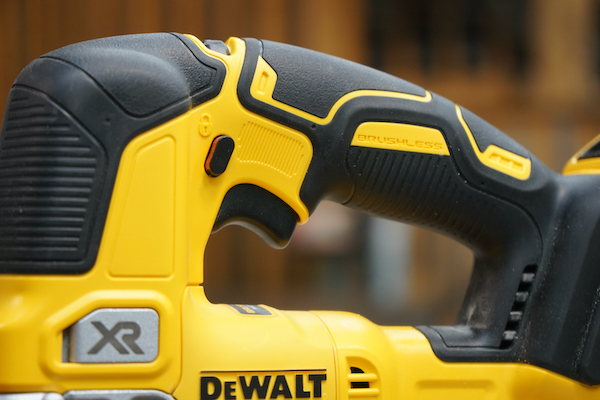
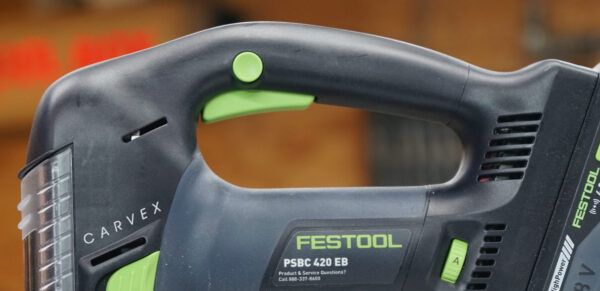
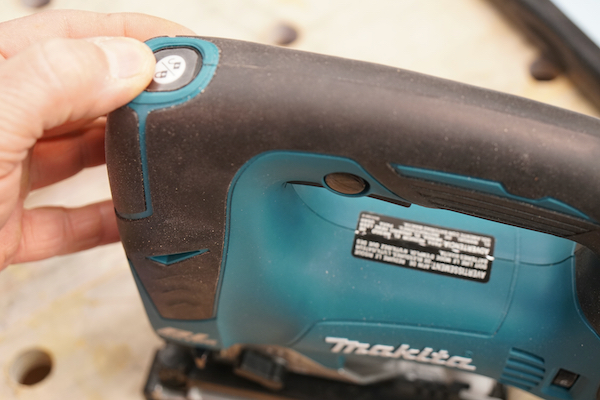
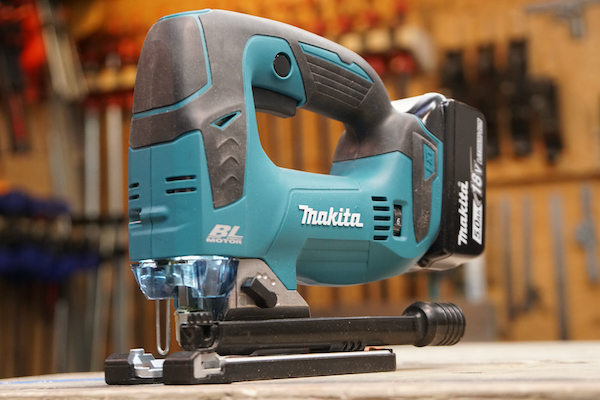
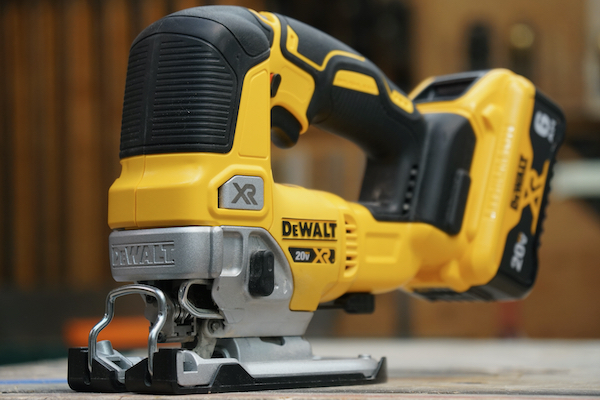
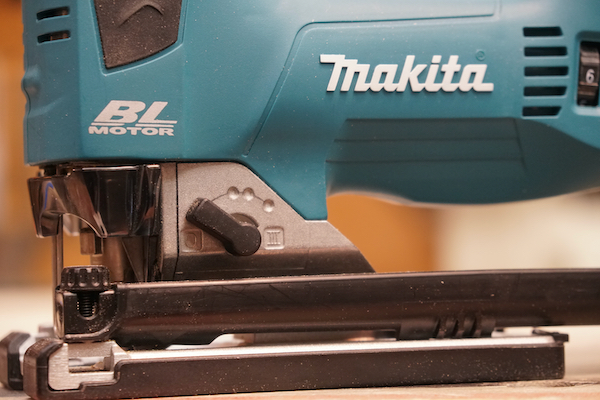
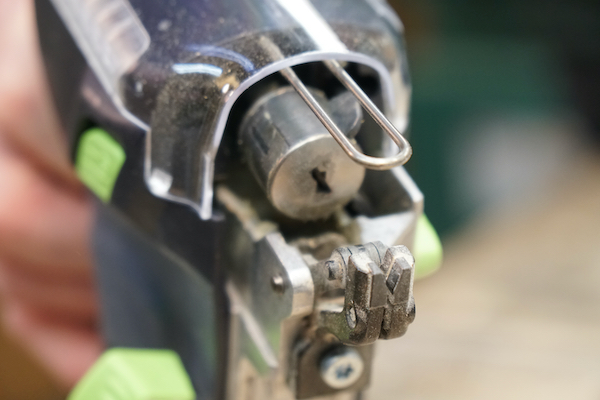
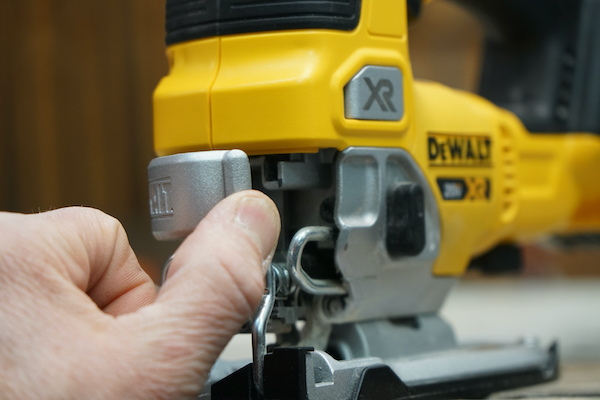
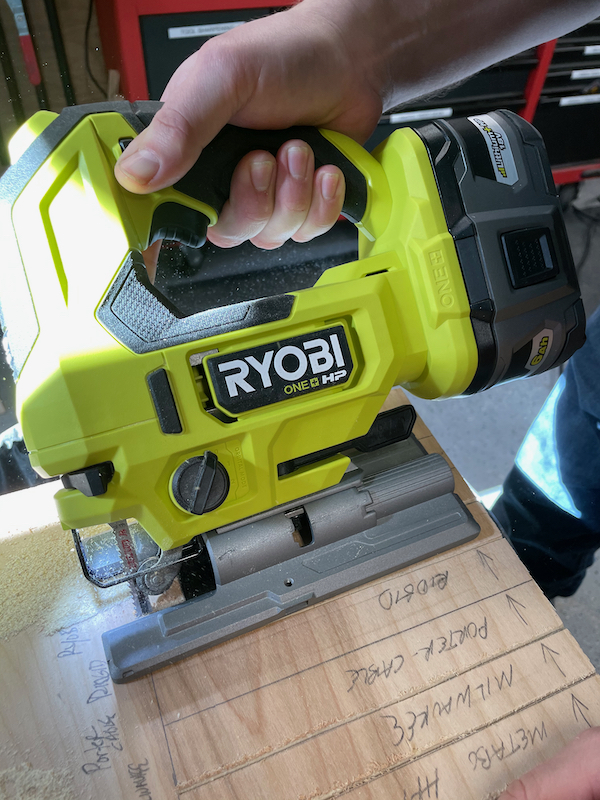
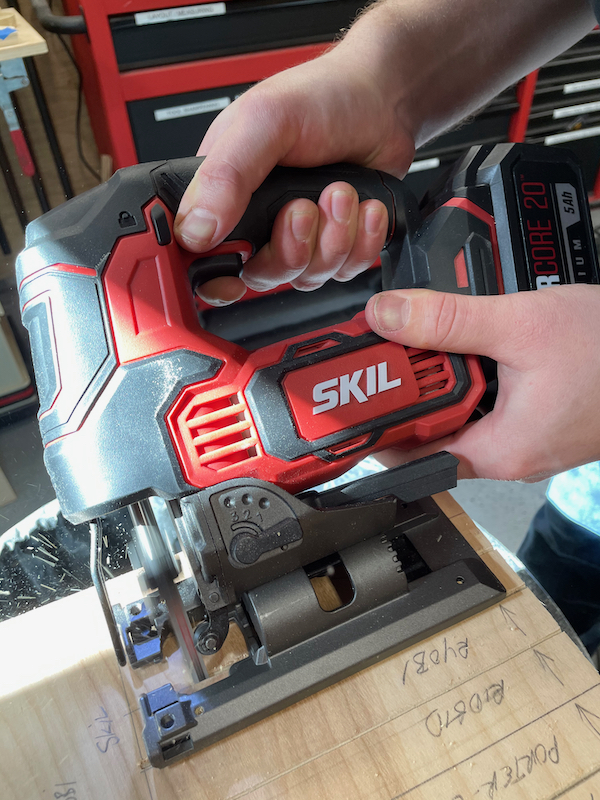
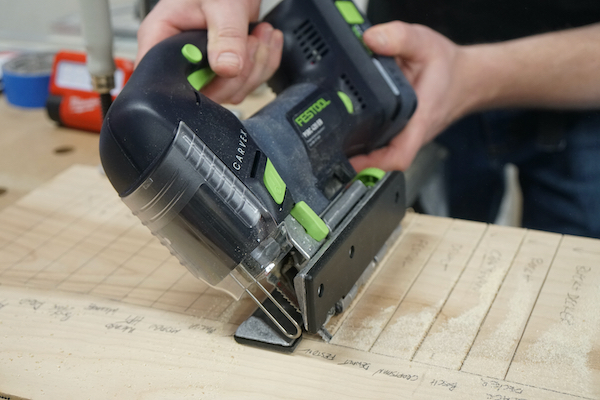
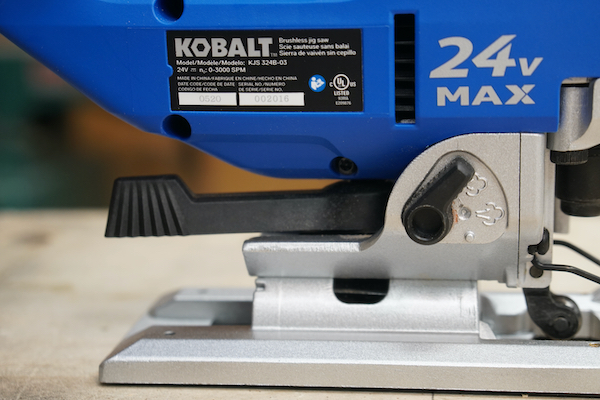
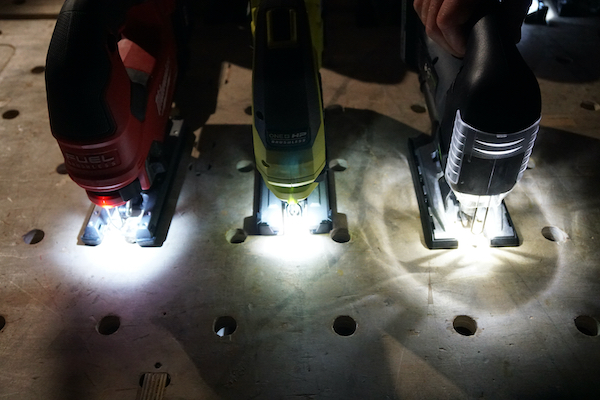
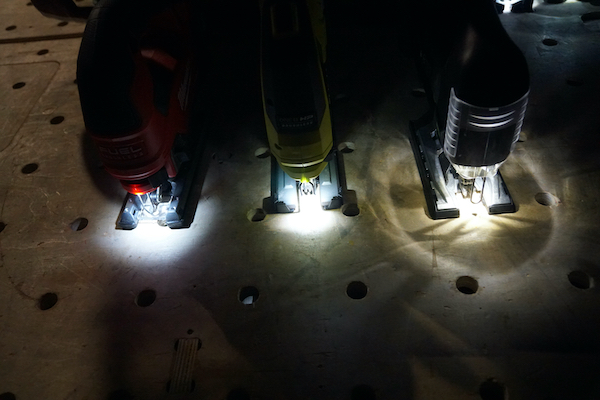
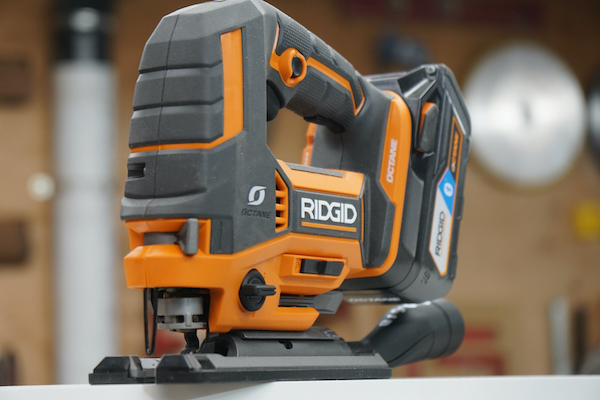
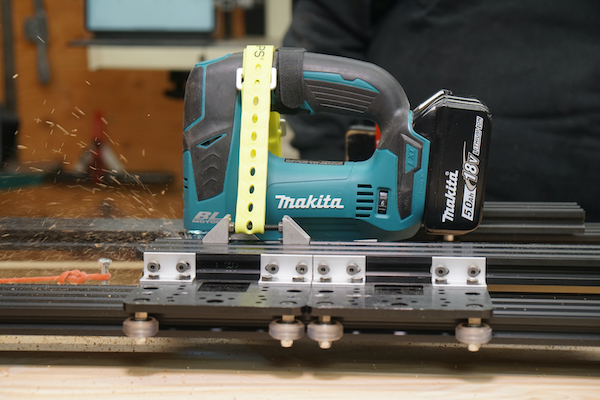
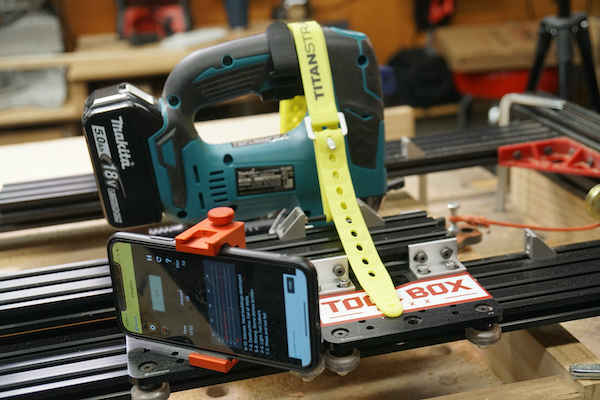
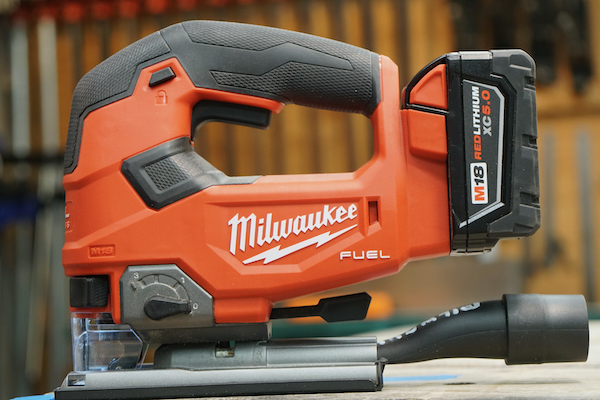
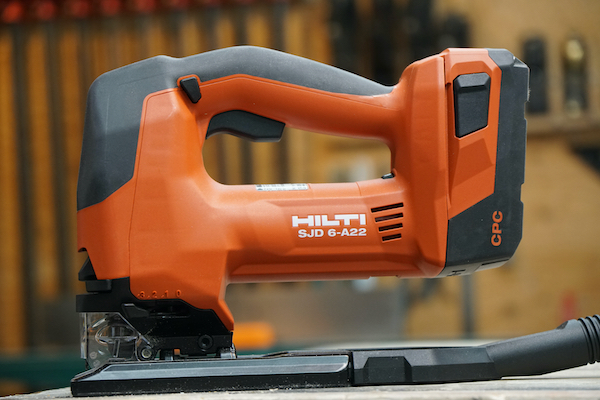
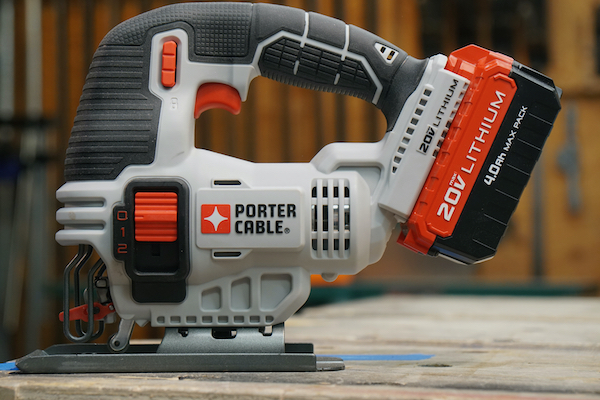
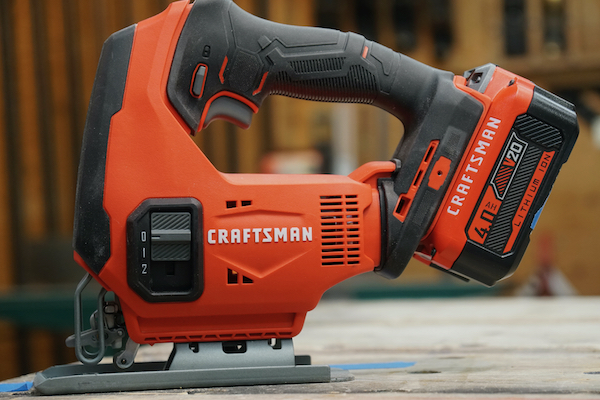
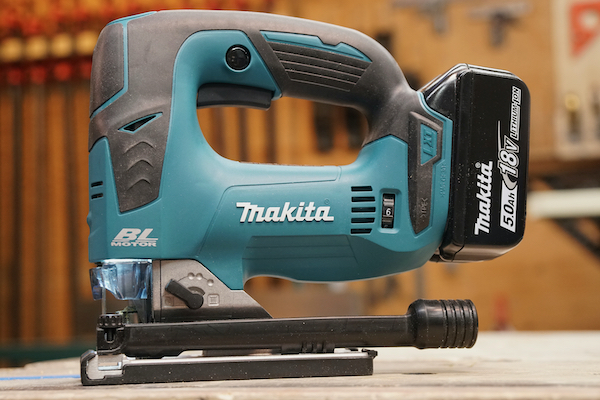
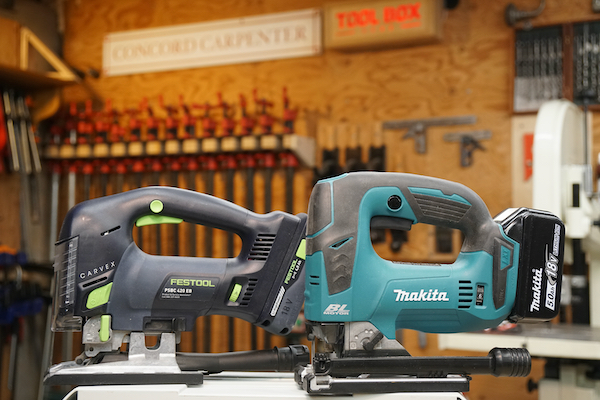
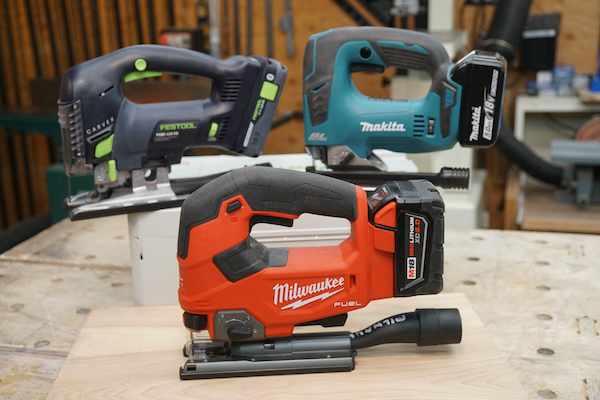
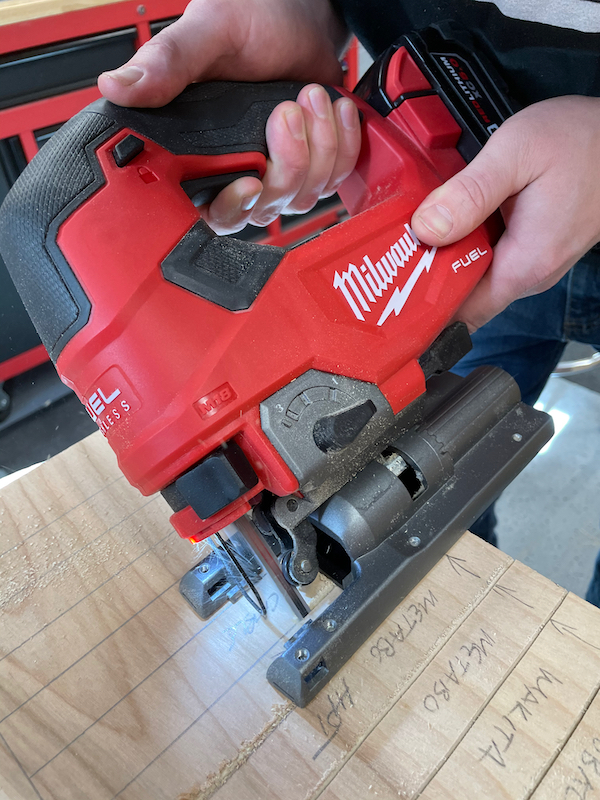
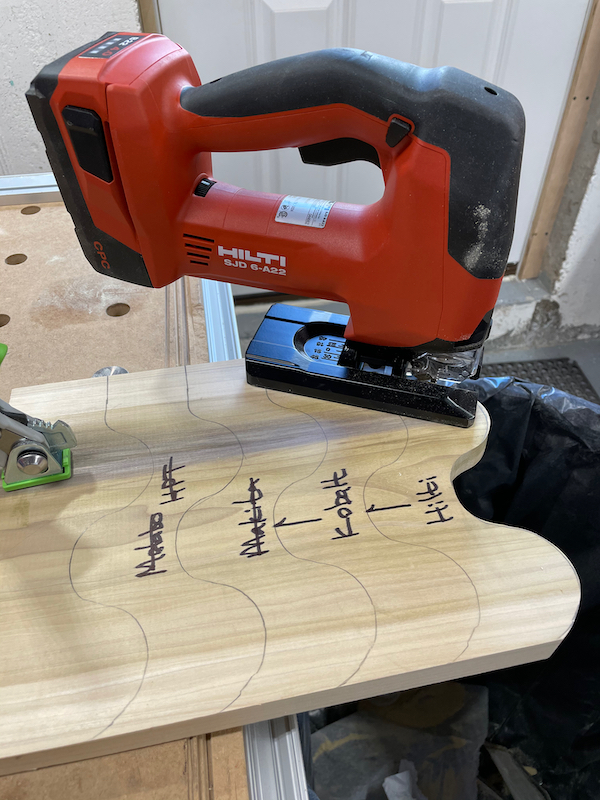
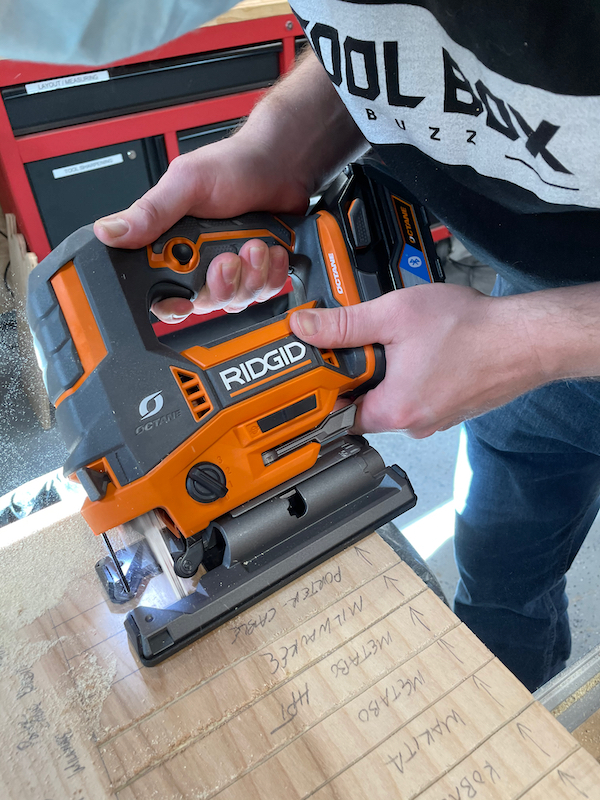
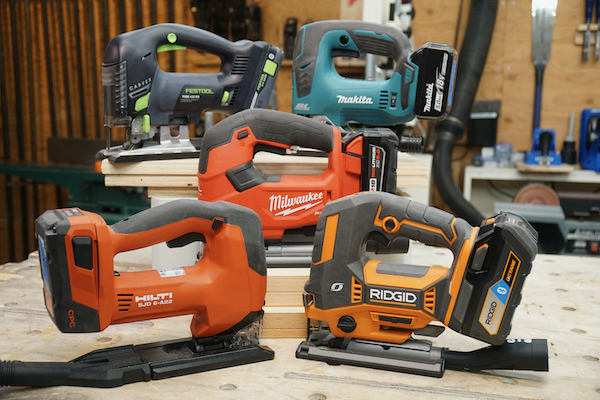

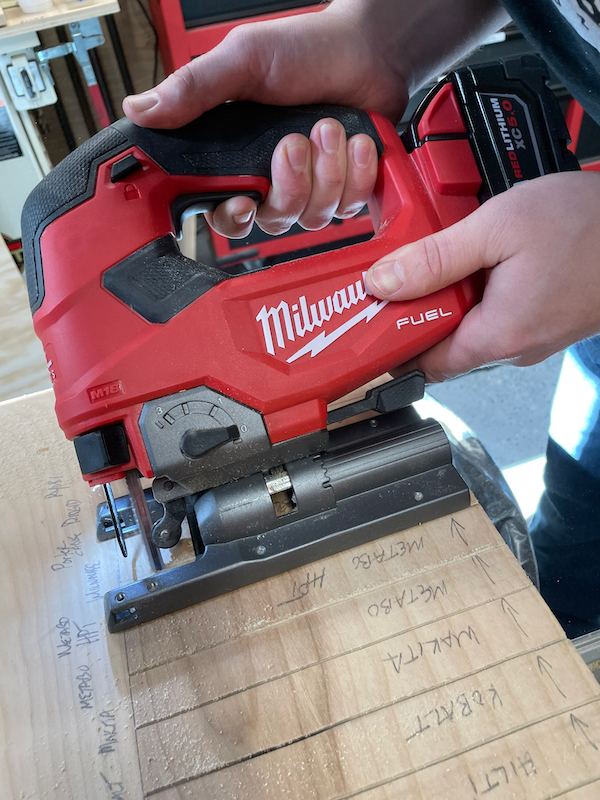

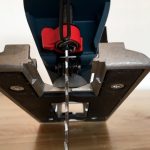
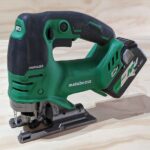












Nice write up! Very thorough. One quibble: the bare tool DeWalt DCS334B is $199 at Lowe’s & Home Depot, as well as $169 ($219 list) right now.
Meant to write $169 at Acme tools, sorry.
fixed thanks
Your math is wrong.
Hilti: 2.84 in per sec divided by 72 watthours is 0.0394
Which is exactly the same result as the Milwaukee… even if you carry it out 12 decimal places.
Mil: 3.55 in per sec divided by 90 watthours is 0.0394
Which would make them tied for first lowering the Milwaukee’s total score to 19 and giving a three way tie for top jigsaw. Additionally, the Festool which only comes with a fixed base and requires an additional purchase to accommodate the 45 degree cut should be graded a 5 in that cut category since the model doesn’t come with a base to allow you to cut a 45 degree angle. This aligns with how other models were scored when they lacked a feature (like a locking trigger) the result would be a total score of 23 moving it down in the total ranking to second. Just my input for all to read, thanks for all your efforts I do value your testing.
We appreciate your looking at the numbers so closely. In the interest of keeping our results digestible, we round numbers up to a reasonable number of significant digits.
So the numbers you saw in the article divided out are correct as far as they stand.
However, the actual average time numbers, when taken out to the 5th / 6th, digit show a more precise answer. The Hilti had a final result of .03946 (rounded up to .0395). The Milwaukee jigsaw had a final result of .03938 (rounded up to .0394).
Our rankings stand as we published them. But we like that our readers go into such detailed depth when looking at what we publish. Thank you for your input.
Sounds good! and thanks again for all your efforts, valuable information indeed!
I’m sure I speak for a small minority (the best & most intelligent always are) but it would be great to state for all future reviews if the tool comes with a carrying case and just how functional that case is. This info wouldn’t be included in any scoring only offered for what it’s worth.
The best testing by a long shot compared to any other write ups I have seen. Not only on the jig saw write up but everything you folks do. If we readers were to rate write ups you guys are number 1.
Very useful, especially since I’m looking to pick up a cordless 18v jigsaw. I’m already into the DeWalt and Makita platforms, so they are the leading contenders. I was planning on the DeWalt barrel grip, but sadly this wasn’t included.
Now I have a conundrum….
The Hilti is 22v not 18v and thus ~88wh and not 72wh. Milwaukee actually won the performance test and should share first place with makita and festool with 19 points.
Would appreciate it if you could edit the article.
Matt – Great catch! We’ve updated the article. However, when all the math finished up, Festool actually was the sole winner with Makita and Milwaukee tied for 2nd.
Thanks for the update! Redoing all the math was very thorough. Congrats to the Festool for taking 1st spot (although I still went with Milwaukee 18v thanks to your excellent website).